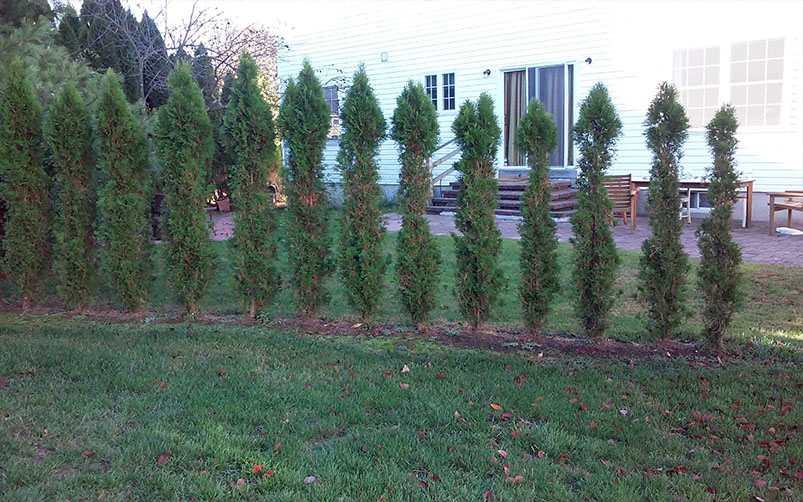Table of Contents
ToggleLast Updated on March 6, 2025
In New Jersey, it’s almost certain that you will see deer on your property throughout the year. With large deer populations, damage to plants is significant and sometimes unavoidable for many homeowners in our area. Many homeowners strive to keep deer away from their landscapes, and we will go over some of the best ways to accomplish that.
Most deer follow a similar movement pattern, meaning they travel from wherever they bed down for the night, to a food source and then back to their bedding area. Depending on their location and the time of year, common food sources may include acorns, farm crops, or your favorite landscape plants. Some common landscape plants they like to feed on are arborvitae, hollies and azalea to name a few. When times get tough for deer and food sources are limited, such as during the winter, even plants advertised as “deer resistant” may still have damage from feeding deer.
Deer feeding may cause permanent damage on some plants, ultimately causing death, however, most times the damage just looks unsightly. Some signs that deer are visiting your property include clipped leaves and hoof prints in the soil around the plants. Deer damage on an arborvitae for instance is very noticeable, as the plant will have a healthy looking top while the bottom areas that deer can reach will be completely bare. Azalea plants produce beautiful flowers each spring if left undamaged during the winter months. Unfortunately, deer like to feed on the foliage and flower buds during the winter, leaving the home owner with fewer flowers and a lot less foliage. A holly plant, like the arborvitae, will look bare on the bottom and fuller on the top. When a plant is damaged, its ability to take up nutrients and distribute them becomes hindered. This type of damage may take years to recover and only if something is done to deter the deer from feeding on the same plant.

Deer damage can also affect the value of your landscape. If you are not willing to wait years for your plants to recover, after using effective deer deterrents, the only option is to remove and replace. That can be costly, therefore our advice is to prevent deer damage immediately after you install landscape plants. Below, we will go over the best practices to keep deer away from landscapes.
Cultural practices to keep deer away
There are deer deterrent products on the market that can help keep deer away. Motion activated sprinklers are one available option that can help deter deer. When deer, or other animals walk by the sensor, it activates the sprinkler and sprays water in the direction of the movement. The sprinklers work best during warm months and cannot be used when temperatures are below freezing. There also sound and light deterrents that are activated with motion sensors as well.
Physical barriers will also help keep deer away. During the winter, consider wrapping susceptible plants in burlap to help minimize damage. Chicken wire can also be an effective way to protect plants from hungry deer. Finally, deer fencing is also an option but needs to be tall enough to keep deer from jumping over.
Another cultural option is to use deer resistant plants. That being said, if the deer are hungry enough, especially during tough winter months, they will feed on them as well.
Deer Repellent Sprays
There are many sprays available on the market such as Bobbex, Liquid Fence, and Repels All. Most of these sprays are all natural and can be made of many different things that can deter deer (typically eggs, pepper, garlic). These sprays go right onto the foliage of the plants. Most sprays only last a week or two and require multiple treatments. Rain and sunlight will also break down these sprays faster.
We use a product called Deer Off in our repellent program to keep deer away from landscapes. The main ingredients are Putrescent Whole Egg Solids (rotten eggs), Capsaicin and related Capsaicinoids (hot pepper extract), garlic and other ingredients. This product is reminiscent to the smell and look of hot sauce. The Deer Off product will last about a month on the plant material which is why our deer repellent program offers monthly treatments to help minimize damage.
All these methods are just tools in your arsenal they are meant to help reduce feeding and to help keep deer away from your valuable landscape. Unfortunately, there is no guarantee that the above practices will eliminate the deer from feeding on your landscape plants, but they will certainly help reduce the damage.
Conclusion
New Jersey has a lot of deer, especially in our area. Protecting your plants can be a difficult task, even with all of the available options. If you live in our service area and have problems keeping deer away from your plants, feel free to give us a call at 908-281-7888 for a free estimate.

